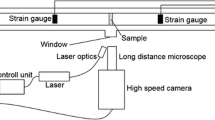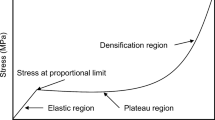Summary
The effects of strain-rate, moisture content, and bulk density on the transverse fracture properties of Pinus radiata wood are described. As the strain-rate is increased from 2×10-6 sec-1 to 102 sec-1, the strengths of both wet and airdry woods increase, with the greater increase occuring in wet wood. At the same time, the failure strain tends to decrease. The energy absorbed by airdry wood decreases, and that absorbed by wet wood increases. An explanation of the variation of strength with strain-rate is developed. Initially the measured strength of latewood is related to the strength of the compound middle lamella matrix connecting adjacent tracheids, and then by making the assumption that wood failure occurs when a certain proportion of the load bearing hydrogen bonds in the matrix have failed, and by applying reaction rate theory to the formation and rupture of the stressed hydrogen bonds, a strength versus time to failure relationship that is in good agreement with the experimental data is derived.
Similar content being viewed by others
References
Atack, D., May, W. D., Morris, E. L., Sproule, R. N. 1961. The energy of tensile and cleavage fracture of Black Spruce. Tappi 44 (8): 555.
Cousins, W. J. 1972. Some physical processes involved in deformation and fracture. PhD Thesis, Victoria University of Wellington, New Zealand.
Fengel, D. 1969. The ultrastructure of cellulose from wood. I. Wood as the basic material for the isolation of cellulose. Wood Sci. Technol. 3: 203.
Garrett, G. A. 1931. The mechanical properties of wood. p 159, Chapman and Hall, London.
Glasstone, S., Laidler, K. I., Eyring, H. 1941. Theory of rate processes. McGraw Hill, New York.
Goring, D. A. I. 1971. in K. V. Sarkanen and C. H. Ludwig (Eds.) Lignins, occurence, formation, structure and reactions. Wiley-Interscience, New York and London.
Hearmon, R. F. S. 1948. Great Britain D.S.I.R. Forest Products Research Special Report No. 7, HMSO.
Hill, R. 1965. Theory of mechanical properties of fibre strengthened materials. III. Self consistent model. J. Mech. Phys. Solids 13: 189.
James, W. L. 1962. Dynamic strength and elastic properties of wood. Forest Prod. J. 12 (6): 253.
James, W. L. 1968. Static and dynamic strength and elastic properties of ponderosa and Loblolly pine. Wood Sci. 1 (1): 15.
Jaswon, M. A., Gillis, P. P., Mark R. E. 1968. The elastic constants of native crystalline cellulose. Proc. Roy. So A 306: 389.
Kauman, W. G. 1966. On the deformation and setting of the plant cell wall. Holz Roh-Werk-stoff 24 (11): 551.
Kingston, R. S. T., Clarke, L. N. 1961. Some aspects of the rheological behaviour of wood. Austral. J. Appl. Sci. 12 (2): 211.
Kollman, F. P., Côté, W. A. Jr. 1968. Principles of wood science and technology. I. Solid wood, George Allen & Unwin Ltd., London; Springer Verlag, Berlin, p 302.
Lekhnitskii, S. G. 1963. Theory of elasticity of an anisotropic elastic body, p 25. Holden-Day Inc., San Francisco.
Liska, J. A. 1955. Effect of rapid loading on the compressive and flexural strength of wood. U.S. For. Serv. Res. Pap. U.S. For. Prod. Lab., Madison. No. R1767.
Mark, R. E. 1967. Cell wall mechanics of tracheids. Yale University Press, New Haven and London.
Nissan, A. H., Sternstein, S. S. 1962. Cellulose as a viscoelastic material. Pure Appl. Chem. 5: 131.
Page, D. H. 1963. The rheology of paper in terms of its molecular structure. Tappi 46 (12): 750.
Panshin, A. J., De Zeeuw, C. 1970. Textbook of wood technology. Vol. I, p 226. McGraw Hill, New York.
Porter, A. W. 1964. On the mechanics of fracture in wood. Forest Prod. J. 14 (8): 325.
Rance, H. F. 1948. Some new studies on the strength properties of paper. Proc. Papermakers Assn. G.B.I.
Suzuki, M., Nakato, K., Aikawa, K. 1965. Frequency dependence of dynamic Young's modulus of wood and its relation to creep. J. Jap. Wood Res. Soc. 11 (3): 76.
Timell, T. E. 1967. Recent progress in the chemistry of wood hemicelluloses. Wood Sci. Technol. 1: 45.
Timoshenko, S. 1945. Strength of materials. II. Advanced theory and problems. Van Nostrand and Co., New York.
Ylinen, A. 1959. On the influence of the rate of deformation on the ultimate strength of wood. Holz Roh-Werkstoff 17 (6): 231. (in German).
Author information
Authors and Affiliations
Additional information
The work described below was carried out at the Physics and Engineering Laboratory as part of a PhD research program at the Victoria University of Wellington.
Rights and permissions
About this article
Cite this article
Cousins, W.J. Effects of strain-rate on the transverse strength of Pinus radiata wood. Wood Science and Technology 8, 307–321 (1974). https://doi.org/10.1007/BF00351864
Received:
Issue Date:
DOI: https://doi.org/10.1007/BF00351864




